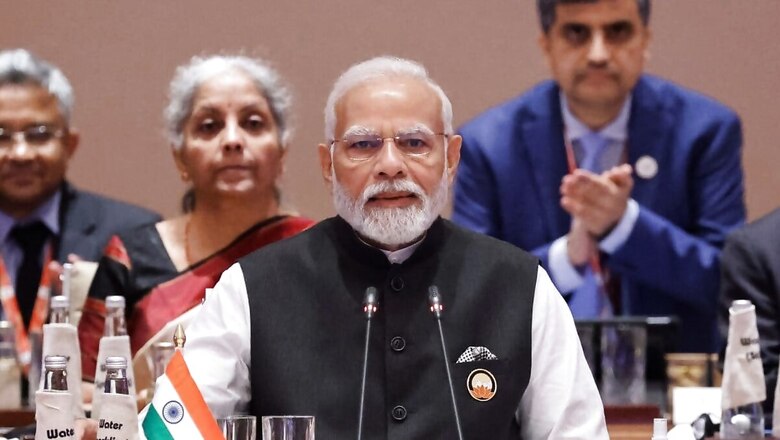
views
The largest democratic process in the world, the Indian Lok Sabha elections 2024, has attracted the attention of one and all across the globe. This general election is a watershed moment for Bharat which will initiate the country towards its new self of ‘Viksit Bharat’ by 2047. Besides, it also holds the possibility of establishing India’s dynamic presence on the global stage.
In academic discourses, it is often said that in the last ten years, under the dynamic leadership of Prime Minister Narendra Modi, India, today is in the final stage of decolonisation. Under the visionary captaincy of Modi, Bharat, which was called “sone ki chidiya” i.e. the golden bird, in ancient times, is re-emerging as an economic power, recovering from hundreds of years of ‘slavery’ post-colonisation. Besides, it has also forged a new identity on the global stage with its scientific, strategic and ‘soft’ power.
However, the anti-India international forces are not able to digest Bharat’s new rise and are trying to hinder its advancement. The international media coverage, particularly news reports, articles, and editorials concerning Modi and the 2024 Lok Sabha elections, serves as one of the most reliable indicators of this negative approach towards Bharat.
In keeping with the idea that Bharat was called the golden bird once upon a time, the British economist Angus Maddison in his book The World Economy: A Millennial Perspective has shown that India was the richest country and the largest economy in the world till the 10th century, its GDP was more than one-third of the world’s economy, which remained very high till the 16th-17th century. But on account of the loot by external forces and inappropriate domestic policies post-independence, the GDP gradually slumped to 2.6 per cent in 2014. It is only with the efficient implementation framework created by the Narendra Modi government that India jumped from the 10th largest economy of the world in 2014 to the fifth largest economy today.
By 2027, hopefully, we are going to be the third-largest economy. Along with this, India’s influence has also increased on global platforms, strategically and scientifically. With the successful launch of Chandrayaan-3 to the Moon, the nation has registered its presence strongly in the field of science and technology. It has also emerged as a major exporter in space industry and defence equipment. Also, providing Covid vaccines to the entire world during the pandemic and showcasing its prowess in the G20 meeting and other international platforms has added to India’s prestige manifold in the world today. Unfortunately, India’s rise has not gone well with certain vested interests, inimical to Bharat, in Pakistan, China, the Arab world as well as Western countries. These forces feel envious of India’s remarkable progress under the leadership of Modi, marching towards Viksit Bharat @2047.
That is why it can be seen that these anti-India forces are trying to influence the Lok Sabha elections in an effort to stop Modi’s visionary drive towards progress that he has envisaged for the country. There seems to be a sinister conspiracy to influence the Indian voters by running a ‘well-planned campaign’ at the global level.
Naseem Javed, a corporate political philosopher and currently the president of the Canadian think tank Expothon Worldwide, in his book titled Alpha Dreamers: The Five Billion Connected Alpha Dreamers Who Will Change the World in 2019 writes, the people in the world, today, are interconnected. Global public opinion is now an authentic voice. This global public opinion can be used by various forces to influence any country. It would be pertinent to note in this context the international media’s attitude vis-a-vis current elections in India.
Whether it’s The New York Times of the US, England’s The Guardian, Qatar’s (Arabia’s) Al Jazeera, Pakistan’s The Dawn or China’s The People’s Daily Online, there is a common thread seen in all – the portrayal of Narendra Modi and the BJP as the villain, whereas no negative sentiment could be found against Rahul Gandhi and his Congress or other Opposition parties. However, a paradox can be seen in all these newspapers as, despite their strong criticism, all of them believe “aaega toh Modi hi” (only Modi will win again).
The New York Times on April 20, 2024, wrote, “In this year’s elections, the scion of India’s most storied political family (Rahul Gandhi) is still trying to unseat Modi — and change the nation’s course…he’s modelling himself after Mahatma Gandhi. He doesn’t want to take any position of power”. Whereas, the publication on April 23, 2024, portrayed Modi as a villain, and commented that he abolished the semi-autonomy of the Muslim-majority state of Jammu and Kashmir; enacted a citizenship law (CAA) widely viewed as prejudiced against Muslims; and helped construct a grand Ram Mandir. These comments come at a time when it has been understood both at the national and international level that all these measures were taken to correct long-standing historical mistakes.
It’s not without reason that the public opinion of the nation remained in favour of Modi all this time. Similarly, Al Jazeera on April 12, 2024, was critical of Modi being portrayed as Bhishma Pitamah, the famous character of the epic Mahabharata, using Artificial Intelligence (AI). It must be noted that the image of Bhishma Pitamah is that of a great selfless character who was detached from the throne and wanted to keep the state safe and secure from all sides. In another story, Al Jazeera on April 19, 2024, posed the question, “Can Sunil Kanugolu (Congress poll strategist) bring India’s Modi down?”
On the other hand, The Guardian, on April 18, 2024, was seen as troubled by the fact that “Modi’s Hindu nationalist agenda has won him support among swathes of India’s 80 per cent Hindu majority, often enabling him to transcend traditional caste and class barriers to win votes among poorer, rural, and lowest caste communities as well as affluent urban voters and the rising middle classes. He has also gained accolades for being seen to have elevated India into a world power being courted by the West, and many of his supporters say Modi has made them proud to be Indian.” Despite the immense popularity of Modi, ‘anti-India’ newspaper The Guardian malevolently wishes in its editorial of April 17, 2024, that “Indian voters ought to think hard about giving Narendra Modi another popular mandate”. Similarly, The People’s Daily Online, the official newspaper of the Chinese Communist Party on April 22, 2024 wrote, showing a fake concern, “Despite India’s economic growth under Modi’s leadership in the past decade, the path driven by nationalism sentiment seems unsustainable.”
The Dawn on April 29, 2024, showed its disappointment saying that the BJP’s popularity among Dalit voters has grown considerably and the fact that a party dominated by upper-caste Hindus is getting votes from lower-caste groups deserves more explanation. The same newspaper in its “incisive analysis” explains this as the outcome of “the tactical use of caste-centric rhetoric” completely ignoring how the Modi government, through dozens of schemes like Awas Yojana, Shauchalay Yojana, Ujjwala Yojana, Har Ghar Jal, Ayushman Bharat etc. has transformed the lives of the people belonging to the lower strata of society irrespective of the caste barrier.
One can conclude, through the aforementioned facts, that these international newspapers are not comfortable with India’s rise and are wary of it growing powerful. They seem to be making a well-planned attempt to influence the Indian elite class, and through them, ultimately the Indian public opinion against Narendra Modi. Many narratives are being floated against Modi. But these so-called champions of democracy turn a blind eye to the bhrashtachar (corruption), tushtikaran (appeasement), parivarvad (nepotism), jaatiwad (casteism) and kshetrawad (regionalism) of the Opposition parties.
The striking similarity in the tone of the international press and the Indian Opposition raises the question: is this a mere coincidence, or a deliberate strategy? But the Indian public, determined to reach the goal of Viksit Bharat, understands its interests very well and is determined to give a befitting reply to the international media on June 4, 2024.
Niranjan Kumar is a Senior Professor at the central Hindi Department, University of Delhi. He tweets @NiranjanKIndia. Views expressed in the above piece are personal and solely that of the author. They do not necessarily reflect News18’s views.




















Comments
0 comment